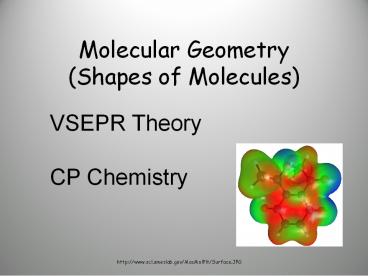Molecular Geometry (Shapes of Molecules) - PowerPoint PPT Presentation
1 / 13
Title:
Molecular Geometry (Shapes of Molecules)
Description:
Molecular Geometry (Shapes of Molecules) VSEPR Theory CP Chemistry http://www.scl.ameslab.gov/MacMolPlt/Surface.JPG VSEPR Theory Electron groups around the central ... – PowerPoint PPT presentation
Number of Views:262
Avg rating:3.0/5.0
Title: Molecular Geometry (Shapes of Molecules)
1
Molecular Geometry(Shapes of Molecules)
VSEPR Theory CP Chemistry
http//www.scl.ameslab.gov/MacMolPlt/Surface.JPG
2
VSEPR Theory
- Electron groups around the central atom will be
most stable when they are as far apart as
possible we call this valence shell electron
pair repulsion theory - because electrons are negatively charged, they
should be most stable when they are separated as
much as possible - The resulting geometric arrangement will allow us
to predict the shapes and bond angles in the
molecule
3
Electrons vs. Molecular Geometry
- The geometry of electron pairs around a central
atom is called the electron geometry. - The arrangement of bonded nuclei around a central
atom forms the molecular geometry. - Lone pair electrons on a central atom will repel
other pairs but will not be visible in the
molecular geometry (no nuclei) - If there are lone pairs on the central atom the
electron geometry and the molecular geometry will
differ.
4
Two electron pairs on central atom
Examples CS2, HCN, BeF2
5
- 3 electron
- pairs on central atom
- All are in bonds
- Trigonal Planar Shape
Examples SO3, BF3, NO3-, CO32-
6
- 3 Electron Pairs
- 2 Bonded
- 1 Un-Bonded
Bent Shape
- Un-bonded electron pair takes up more space and
repels more. - The bond angle will change to less than the
original 120o to about 117o-115o
- Other Examples
- SO2, O3, PbCl2, SnBr2
About 117o
7
- Four electron pairs on central atom
- All 4 in bonds
Examples CH4, SiCl4, SO42-, ClO4-
8
- 4 Electron Pairs
- 3 bonded
- 1 un-bonded (lone pair)
- Trigonal Pyramidal Shape
Examples NH3, PF3, ClO3. H3O
Bond angles are reduced from 109.5o to 107o due
to extra repulsion by lone pair
9
4 Electron Pairs 2 Bonded 2 Un-bonded (lone
pairs) BENT SHAPE
Examples H2O, OF2, SCl2
Bond angles are reduced a little more due to
repulsion To 104.5o
10
The steps in determining a molecular shape
11
Representing 3-Dimensional Shapes on a
2-Dimensional Surface
- One of the problems with drawing molecules is
trying to show their dimensionality - By convention, the central atom is put in the
plane of the paper - Put as many other atoms as possible in the same
plane and indicate with a straight line - For atoms in front of the plane, use a solid
wedge - For atoms behind the plane, use a hashed wedge
12
Predicting Molecular Shapes with Two, Three, or
Four Electron Groups
The shape is based upon the tetrahedral
arrangement.
The F-P-F bond angles should be lt109.50 due to
the repulsion of the nonbonding electron pair.
The final shape is trigonal pyramidal.
lt 109.50
13
Predicting Molecular Shapes with More Than One
Central Atom
Find the shape of one atom at a time after
writing the Lewis structure.
SOLUTION






























